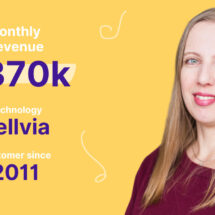What Is Click Rate? How to Track, Improve, and Use It Effectively
By Sean Tinney May 6, 2025
Ever sent off an email campaign and wondered how many people actually engage with it beyond just opening? That moment when someone clicks a link inside your message is crucial—it means they’re interested enough to take action. But how do you measure this engagement, and what does a ‘click rate’ really show? Understanding click rate can transform the way you approach your email marketing, digital ads, and even social media strategy.
What is click rate?
Simply put, a click rate measures the percentage of recipients who click on a link in your message—email, ad, or post—out of the total number delivered. It’s a powerful indicator of how compelling and actionable your content is. Knowing your click rate helps you see what’s working, what isn’t, and how you can boost engagement with your audience.
If you’ve ever asked yourself, “What is a click rate and how is it different from click-through rate?” you’re not alone. Let’s break it down and explore not just definitions, but real strategies for using this key metric to grow your results.
Click Rate vs Click Through Rate: What’s the Real Difference?
It’s easy to confuse click rate with click-through rate (CTR) since both measure clicks—but there’s a subtle difference, and it matters for optimizing your campaigns.
Click rate typically refers to the percentage of delivered emails in which at least one link was clicked. Here’s the basic formula for an email campaign:
Click Rate = (Number of Clicks / Number of Delivered Emails) x 100
Example: If you send 2,000 emails and get 80 total clicks, your click rate is 4%. On platforms like AWeber, this is one of the most common KPIs you’ll track in your dashboard.
Click-through rate (CTR), however, often measures the percentage of clicks divided by the number of opens—not deliveries. The formula:
CTR = (Number of Clicks / Number of Opens) x 100
Example: If 1,000 people open your message and 80 click a link, your CTR is 8%.
Knowing the difference between click rate vs click through rate is important. Click rate gives you insight on the impact of your message for everyone who received it, while CTR tells you how compelling your content is for those who actually opened it. Marketers often use both metrics together to track and compare campaign performance.
Understanding how these metrics fit into your broader email marketing KPIs can help you make smarter, data-driven decisions.
Why Click Rate Matters for Your Email and Digital Marketing
You might wonder whether it’s worth tracking yet another metric. Here’s why click rate deserves your attention:
- Shows engagement: Unlike open rates (which just measure who glanced at your message), click rate proves people are taking action.
- Highlights content effectiveness: If your links are getting lots of clicks, your content is resonating. If not, it could be time to switch up your calls to action or design.
- Improves deliverability: High engagement signals to email providers that your messages are valuable, which can help your future emails avoid spam folders (Federal Trade Commission).
- Helps optimize campaigns: Tracking click rates over time helps you see what works, so you can focus on tactics that truly drive results.
Whether you’re running an email newsletter, a digital advertisement, or a customer nurture series, understanding “what is click rate” will equip you to measure, learn, and improve.
How to Calculate Click Rate: Step-by-Step
If you’re using a platform like AWeber, click rates are typically calculated automatically and displayed on your dashboard. Still, it’s helpful to know the formula behind the stat so you can interpret your data confidently.
Here’s how to calculate it manually:
- Count the total number of clicks your link(s) received. Some platforms show total clicks, others show unique clicks (people who clicked at least once).
- Divide by the total number of emails delivered. (Don’t include emails that bounced.)
- Multiply by 100 to get a percentage.
Example: Let’s say you delivered 1,500 emails, and your campaign generated 45 unique clicks. 45 ÷ 1500 x 100 = 3% click rate. On AWeber, this number is automatically tracked under your campaign results page with helpful details and even click maps.
What Is a Good Click Rate?
It’s natural to wonder how your campaign compares to others. Industry standards for click rates can vary, but here are a few benchmarks:
- Email campaigns: Average click rates often range from 2% to 5%, but this depends on your industry and list quality.
- Digital advertising: Banner ad click rates tend to be lower—sometimes below 1%—while search or social ads may see 2-3% or more (Harvard Business School research).
- Transactional emails (like receipts): These often score higher click rates because recipients expect and want the content.
Instead of chasing a magic number, focus on improving your own baseline over time. Consistent tracking and testing are more powerful than comparing to broad industry standards. For in-depth industry averages, explore AWeber’s email marketing statistics.
How to Improve Your Click Rate: Actionable Strategies
Ready to level up your click rate? Here are data-backed strategies you can put into practice right away:
1. Write Compelling Calls to Action (CTAs)
Clarity wins every time. Try using action words and be specific: “Download Your Free Guide” is stronger than “Click Here.” In your AWeber account, test different CTAs using split tests for subject lines and visual layouts.
2. Optimize Link Placement and Design
People pay more attention to the first few lines and prominent buttons. Place your main CTA above the fold, and use bold styling for links. Adding clickable buttons (rather than just text links) can dramatically increase clickable engagement.
3. Personalize Content
Segment your audience so recipients get content that’s relevant to their needs and interests. For example, if you run a bookshop, subscribers interested in thrillers should receive tailored recommendations and links.
4. Test, Learn, and Iterate
Experiment with subject lines, time of day, copy, and even email design. AWeber’s reports let you compare campaigns over time and single out the highest click drivers. Use this data to refine your approach each month.
When to Apply Click Rate Insights
So, when does click rate matter most? Any time you want to gauge the effectiveness of your call to action and audience engagement, click rate is your friend. Here are a few practical scenarios:
- Launching a new product: See which links (e.g., product info, demos) are most engaging.
- Segmenting your audience: Email subscribers who click a particular link can be tagged, then sent personalized follow-up emails automatically.
- Comparing campaign types: Use click rate vs click through rate to analyze which campaign styles are more effective—promotional vs educational, for example.
- Optimizing landing pages: If you notice high email click rates but low conversions on your website, it signals a problem with your landing page rather than your campaign.
Common Misconceptions About Click Rate
As you work with click rate data, keep these points in mind:
- Click rate does not equal sales: High click rates mean good engagement, but you should always track sales and other downstream actions to measure ultimate ROI.
- One-click per recipient: Some metrics measure total clicks; others measure unique clicks (one per person). Always check which your platform tracks—AWeber surfaces both for clarity.
- Click rate isn’t the only metric: Combine with opens, conversions, and unsubscribe rates for a holistic view of campaign performance.
Quick FAQ: Everything You Need to Know About Click Rate
- What is click rate? — It’s the percentage of recipients who clicked a link out of the total delivered messages.
- Is click rate the same as click through rate? — Not always. Click rate measures clicks vs delivered, while click through rate (CTR) is usually clicks vs opens.
- How can I improve click rate? — Make your content relevant, use clear CTAs, test placements, and segment your list.
- Where do I find my click rate in AWeber? — In the email campaign analytics dashboard. Look for both total and unique click data.
When you understand what is a click rate and how it fits into your overall marketing picture, you gain a powerful tool to sharpen your strategy. By tracking, analyzing, and acting on click rate insights, you can engage your audience more effectively and move closer toward your marketing goals. Want to learn even more? Check out AWeber’s resource center for advanced tips on email marketing and more.

